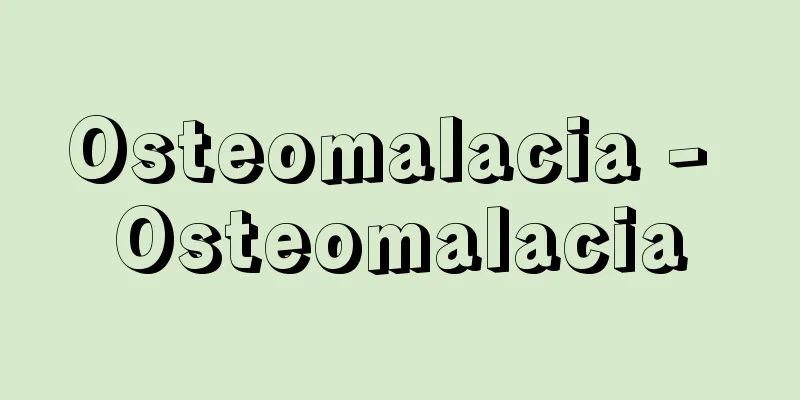Osteomalacia - Osteomalacia

|
◎ The principle of treatment is oral administration of vitamin D [What kind of disease is it?] Bones are hard tissues formed by the deposition (calcification) of minerals such as calcium and phosphorus into a meshwork of a protein called collagen (called osteoid). When bone mineralization is impaired for some reason and the soft bone, osteoid, increases, this condition is called rickets in children and osteomalacia in adults. In other words, rickets and osteomalacia are exactly the same disease. In osteoporosis, which causes bones to become brittle, bone mass decreases, whereas in osteomalacia, the non-calcified areas, or osteoid, increase. Because osteoid is not sufficiently mineralized, it does not show up on X-rays, making it appear as if you have lost bone mass. [Cause] In order for osteoid to calcify and become normal hard bone, calcium, phosphorus, and vitamin D are required. Causes of osteomalacia include nutritional deficiency (often after gastrectomy), tumor-related, congenital, kidney or liver disorders, and the use of anticonvulsants or iron supplements. Deficiencies are more often due to vitamin D deficiency than calcium or phosphorus deficiency. In particular, there has been an increase in cases of osteomalacia caused by impaired vitamin D absorption after stomach resection, while cases of osteomalacia caused purely by malnutrition have decreased compared to the past. In order for the function of vitamin D to be activated in the body, it is important that the kidneys and liver are functioning properly and that exposure to sunlight is sufficient. Therefore, if you have kidney or liver disease or have been living without sunlight for a long period of time, osteomalacia can develop. [Symptoms] In children, symptoms such as short stature and bowed legs often appear, and the symptoms remain even into adulthood. When adults develop the disease, there are often no symptoms at first, but as the disease progresses, people often experience easy fractures, joint pain similar to rheumatoid arthritis, and back pain (pain in the lower back and back). Characteristic symptoms include pain in the thigh (or other area), known as bone pain, as well as muscle weakness and a feeling of weakness. [Testing and diagnosis] X-ray examination of osteomalacia shows a characteristic condition called bone transformation layer, which resembles a fracture. In normal osteomalacia, bone atrophy is seen, but in adult cases of hypophosphatemic osteomalacia, which is caused by low blood phosphorus levels from birth, hardening of the bone is seen. To make a definitive diagnosis, bone tissue must be examined under a microscope to prove the presence of an increase in osteoid, but the diagnosis is usually made based on blood tests showing low calcium and phosphorus levels, elevated alkaline phosphatase levels, and X-ray results. There are various causes of osteomalacia, so it is important to check your kidney and liver, lifestyle habits, and medications you are taking. [Treatment] The principle of treatment is oral administration of vitamin D, but recently more effective active vitamin D preparations have been used. The dosage of vitamin D preparations varies depending on the cause of bone softening. In cases of deficiency, 1.0 μg (microgram) (one millionth of a gram) of alphacalcidol is used per day. In cases of hypophosphatemic osteomalacia, the largest amount is required, and approximately 3.0 μg of alphacalcidol is used per day. In any case, the dosage will be determined by monitoring the calcium and alkaline phosphatase levels in the blood, taking care to avoid developing hypercalcemia. Source: Shogakukan Home Medical Library Information |
|
◎治療の原則はビタミンDの内服 [どんな病気か] 骨は、コラーゲンと呼ばれるたんぱく質の網目(類骨(るいこつ)といいます)に、カルシウムやリンなどのミネラルが沈着(石灰化)して、かたい組織となっています。 なんらかの原因によって骨の石灰化が障害され、やわらかい骨である類骨が増加した状態を、子どもではくる病(「くる病(子どもの骨軟化症)」)、おとなでは骨軟化症といいます。つまり、くる病と骨軟化症は、まったく同じ病気なのです。 骨がもろくなる骨粗鬆症(こつそしょうしょう)(「骨粗鬆症」)では、骨量が減少するのに対して、骨軟化症は、石灰化していない部分、つまり類骨が増えてしまいます。 類骨は石灰化が不十分なので、X線には映らず、まるで骨量が減ったように見えます。 [原因] 類骨が石灰化して正常なかたい骨になるためには、カルシウムやリンのほかに、ビタミンDが必要です。 骨軟化症の原因として、栄養分の欠乏性のもの(胃切除後が多い)、腫瘍(しゅよう)にともなうもの、先天性のもの、腎臓(じんぞう)や肝臓(かんぞう)の障害にともなうもの、抗けいれん薬や鉄剤の使用によるものなどがあります。 欠乏性のものでは、カルシウムやリンの欠乏よりも、ビタミンDの欠乏によることが多くなっています。 とくに胃を切除した後、ビタミンDの吸収が障害されておこる骨軟化症が増加しており、以前に比べて、純粋に栄養不良が原因となる骨軟化症は減っています。 ビタミンDのはたらきが体内で活性化されるためには、腎臓や肝臓が十分機能することと、日光にあたることが重要です。ですから、腎臓や肝臓の病気があったり、長期間、日光にあたらない生活を続けていると、骨軟化症がおこることがあります。 [症状] 子どもの場合は、低身長やO脚(オーきゃく)などが現われることが多く、成人してもそのままの症状が残ります。 おとなが発病した場合は、初めは無症状のことが多いのですが、病気が進行すると、簡単に骨折したり、関節リウマチのような関節痛、腰背痛(ようはいつう)(腰や背中の痛み)などがおこってくることが多いようです。 特徴的な症状としては、骨痛(こつつう)と呼ばれる大腿部(だいたいぶ)(太もも)などの疼痛(とうつう)のほか、筋力低下や脱力感があります。 [検査と診断] 骨軟化症のX線検査では、骨改変層と呼ばれる、骨折と似た状態がみられるのが特徴です。ふつうの骨軟化症では骨の萎縮(いしゅく)がみられますが、生まれつき血中のリンが少ない低(てい)リン血症性骨(けっしょうせいこつ)くる症(しょう)で発症したおとなの症例(低リン血症性骨軟化症)では、むしろ骨の硬化がみられます。 確実な診断をつけるには、骨の組織を顕微鏡で調べ、類骨が増えていることを証明する必要がありますが、通常は血液を調べて、カルシウムやリンの値の低下、アルカリホスファターゼ値の上昇およびX線検査の結果から診断します。 骨軟化症の原因にはさまざまなものがあるので、腎臓や肝臓の検査のほか、生活習慣、服用している薬などを調べることがたいせつになります。 [治療] 治療の原則は、ビタミンDの内服ですが、最近では、効き目の強い活性型のビタミンD製剤が使われています。 どのような原因で骨軟化がおこっているかによって、ビタミンD製剤の投与量が異なります。 欠乏性のものである場合は、アルファカルシドールを1日1.0μg(マイクログラム)(100万分の1g)使用します。低リン血症性骨軟化症では、もっとも大量に必要とし、アルファカルシドールを1日に3.0μg前後使用します。 どのような場合であっても、血液中のカルシウム値やアルカリホスファターゼ値をみながら、高カルシウム血症などにならないように注意して、使用量が決定されます。 出典 小学館家庭医学館について 情報 |
<<: Osteosarcoma - Osteosarcoma
Recommend
Campanula persicifolia (English spelling) Campanula persicifolia
… [Munemin Yanagi]. … *Some of the terminology th...
New Fourth Army (English: Xin-si-jun)
Abbreviation for the New Fourth Army of the Chines...
Yakazu Haikai
A form of haikai. Modeled on the archery competit...
Almeida, MAde - Almeida
...He wrote many novels depicting the landscapes ...
Eridobanda - Eridobanda
...Cultivation through crossbreeding has also bee...
Khvostov, N.
...The following year, the Kuril Islands, along w...
Ichijodani
A long, narrow valley running north to south, crea...
St. Peter's Basilica - St. Peter's Basilica (English name) Basilica di San Pietro in Vaticano
The main cathedral of the Roman Catholic Church in...
Christoph Scheiner
German Jesuit and astronomer. Born in Swabia. He ...
Hakone Pass
Located in the southwestern edge of Kanagawa Pref...
Butter, N. (English spelling) ButterN
…In 1832, these foreign news translation newspape...
Eads Bridge - Eads Bridge
Eads Bridge : A bridge over the Mississippi River ...
maíz (English spelling)
… [Yamamoto Norio] [propagation] It was Columbus&...
Steichen
Photographer and painter. Born in Luxembourg, he e...
Leucandron
...An evergreen tall tree of the Proteaceae famil...









